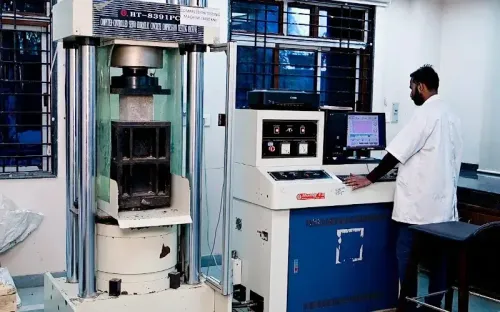Researchers Uncover Crucial Mechanism in Heavy-Ion Cancer Therapy

Synopsis
Key Takeaways
- Heavy-ion therapy is a cutting-edge method that outperforms traditional X-ray treatment.
- More than 50,000 patients have undergone this therapy since its proposal.
- The observed mechanism may revolutionize future radiotherapy techniques.
- IgE antibodies show potential in fighting resistant cancers.
- Collaboration among international researchers is key in these advancements.
New Delhi, March 16 (NationPress) A groundbreaking study has made remarkable strides in revealing the microscopic mechanism behind heavy-ion cancer therapy, which is anticipated to enhance cancer treatment approaches and facilitate the advancement of innovative radiotherapy technologies.
The research, spearheaded by scientists from the Institute of Modern Physics (IMP) of the Chinese Academy of Sciences along with their collaborators, was recently featured as a prominent paper in the journal Physical Review X, as reported by the Xinhua news agency.
Heavy-ion therapy, a state-of-the-art radiotherapy method, employs heavy-ion beams to obliterate cancer cells.
Since its inception in 1946, more than 50,000 patients globally have received heavy-ion treatment.
"With the same radiation dosage, heavy ions demonstrate two to three times enhanced cancer-cell-killing efficacy compared to conventional X-ray radiotherapy," stated Xu Shenyue, a researcher affiliated with the IMP.
Heavy ions can induce DNA double-strand breaks in tumor cells more effectively, leading to more pronounced biological effects.
However, the specific microscopic mechanism responsible for these effects has been elusive, Shenyue remarked.
To investigate this matter, researchers conducted experiments at heavy-ion research facilities located in Lanzhou, in the northwest region of Gansu Province, China.
For the first time, they detected an intermolecular energy and proton transfer cascade mechanism initiated by heavy-ion irradiation within biomolecular clusters.
"The mechanism observed illuminates the molecular processes of radiation damage and may be crucial in refining radiotherapy techniques in the future," commented Ma Xinwen, another researcher from the IMP.
The study was undertaken by scientists from the IMP in collaboration with researchers from Russia's Irkutsk State University, Germany's Heidelberg University, the University of Science and Technology of China, Xi'an Jiaotong University, and Lanzhou University.
Additionally, a recent report indicated that scientists are developing a new type of antibody that could assist in combating treatment-resistant breast and ovarian cancers.
The antibody, known as IgE, has demonstrated potential in stimulating the immune system and inhibiting tumor growth.
Currently, IgG antibodies are widely used in immunotherapy to activate the body’s immune defenses against cancer.
This treatment is generally favored over chemotherapy and radiation as it specifically targets cancer cells.









